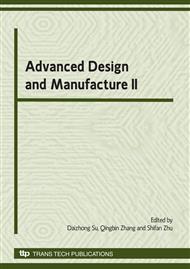p.21
p.25
p.29
p.33
p.37
p.41
p.45
p.49
p.53
Numerical Simulation and Experimental Measurement of a Printed Circuit Board Subjected to Drop Test
Abstract:
Drop test is one of the common methods for determining the reliability of electronic products under actual transportation conditions. The aim of this study is to develop a reliable drop impact simulation technique. The test specimen of a printed circuit board is clamped at two edges on a test fixture and mounted on the drop test machine platform. The drop table is raised at the height of 50mm and dropped with free fall to impinge four half-spheres of Teflon. One accelerometer is mounted on the center of the specimen to measure the impact pulse. The commercial finite element software ANSYS/LS-DYNA is applied to compute the impact acceleration and dynamic strain on the test specimen during the drop impact. The finite element results are compared to the experimental measurement of acceleration with good correlation between simulation and drop testing. With the accurate simulation technique, one is capable of predicting the impact response and characterizing the failure mode prior to real reliability test.
Info:
Periodical:
Pages:
37-40
Citation:
Online since:
October 2009
Authors:
Keywords:
Price:
Сopyright:
© 2010 Trans Tech Publications Ltd. All Rights Reserved
Share:
Citation:


